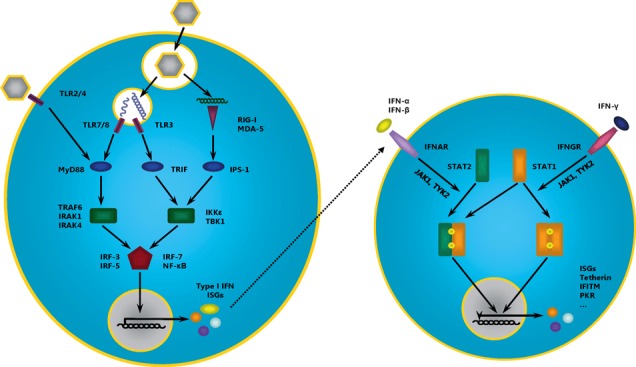Figure 2.

Induction of type I IFNs and ISG expression. Recognition of viral pathogen‐associated molecular patterns (PAMPs) by PRRs (purple) in infected cells initiates a signalling cascade including adaptor molecules (blue) and kinases (green), which activate transcription factors (red) that induce the expression of type I IFNs and ISGs (left panel). Binding of IFN‐α/β and IFN‐γ to their receptors induces phosphorylation (by JAK1/TYK2), dimerization and nuclear translocation of STAT transcription factors, which induce the expression of several ISGs such as tetherin, IFITM, PKR and others (right panel). IFN, interferon; TLR, Toll‐like receptor; RIG‐I, retinoic acid‐inducible gene I; MDA‐5, melanoma differentiation‐associated gene 5; MyD88, myeloid differentiation primary response protein 88; TRIF, TIR domain‐containing adaptor‐inducing IFN‐β; IPS‐1, IFN‐β promoter stimulator 1; TRAF6, tumour necrosis factor receptor‐associated factor 6; IRAK, interleukin‐1 receptor‐associated kinase; IKKε, IκB kinase ε; TBK1, tank‐binding kinase 1; IRF, IFN regulatory factor; NF‐κB, nuclear factor κ light chain enhancer of activated B‐cells; ISG, IFN‐stimulated gene; IFNAR, IFN‐α receptor; IFNGR, IFN‐γ receptor; JAK1, Janus‐activated kinase 1; PRR, pathogen recognition receptor; TYK2, tyrosine kinase 2; STAT, signal transducer and activators of transcription.
